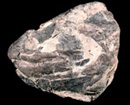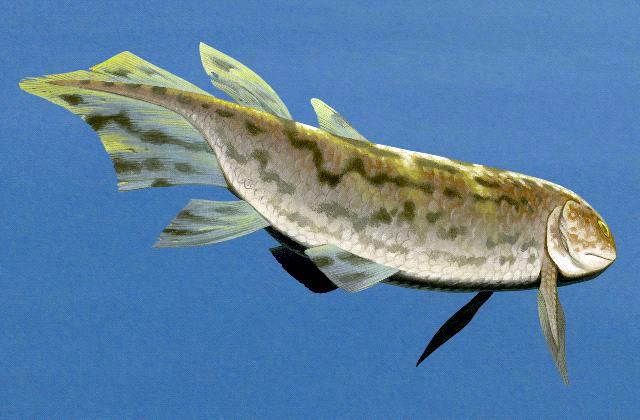Quebecius
With a name like Quebecius quebecensis, it is hard to imagine this fish coming from anywhere else but Quebec!
 (40 kb) Quebecius differs from its fellow porolepiforms and most sarcopterygians in that it bears only one lobed fin, the pectoral fin, and its other fins sport rays that penetrate deeply into its body.
(40 kb) Quebecius differs from its fellow porolepiforms and most sarcopterygians in that it bears only one lobed fin, the pectoral fin, and its other fins sport rays that penetrate deeply into its body.
Quebecius strongly resembles the genus Glyptolepis, another porolepiform that was relatively common during the Devonian. But Quebecius is distinguished from Glyptolepis by a pelvic fin with an unusually large base, a condition not seen in any other porolepiform.
 (64 kb)The few specimens discovered thus far include some that are complete and some with three-dimensional preservation. They range from 5 to 60 cm long and display several growth stages.
(64 kb)The few specimens discovered thus far include some that are complete and some with three-dimensional preservation. They range from 5 to 60 cm long and display several growth stages.
Compared to osteolepiforms, porolepiforms are known for their small operculars, the plate-like bones that cover the gills of a fish. But in Quebecius, this bone is unusually small, even for a porolepiform. Furthermore, the epicercal form of its tail is much more pronounced than for other members of the group. Despite these differences, the species otherwise respects the relatively conservative morphology of porolepiforms.
The low number of specimens at Miguasha, with only about twenty specimens collected thus far, suggests that Quebecius was not a very abundant species in this ancient estuary.

 (40 kb) Quebecius differs from its fellow porolepiforms and most sarcopterygians in that it bears only one lobed fin, the pectoral fin, and its other fins sport rays that penetrate deeply into its body.
(40 kb) Quebecius differs from its fellow porolepiforms and most sarcopterygians in that it bears only one lobed fin, the pectoral fin, and its other fins sport rays that penetrate deeply into its body.Quebecius strongly resembles the genus Glyptolepis, another porolepiform that was relatively common during the Devonian. But Quebecius is distinguished from Glyptolepis by a pelvic fin with an unusually large base, a condition not seen in any other porolepiform.

 (64 kb)The few specimens discovered thus far include some that are complete and some with three-dimensional preservation. They range from 5 to 60 cm long and display several growth stages.
(64 kb)The few specimens discovered thus far include some that are complete and some with three-dimensional preservation. They range from 5 to 60 cm long and display several growth stages.Compared to osteolepiforms, porolepiforms are known for their small operculars, the plate-like bones that cover the gills of a fish. But in Quebecius, this bone is unusually small, even for a porolepiform. Furthermore, the epicercal form of its tail is much more pronounced than for other members of the group. Despite these differences, the species otherwise respects the relatively conservative morphology of porolepiforms.
The low number of specimens at Miguasha, with only about twenty specimens collected thus far, suggests that Quebecius was not a very abundant species in this ancient estuary.




